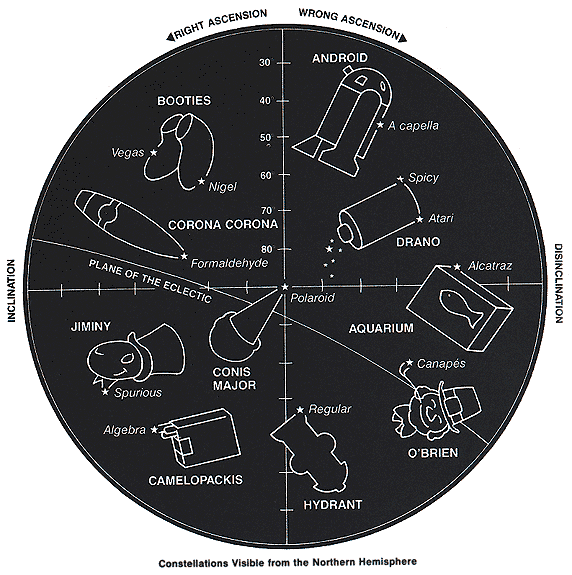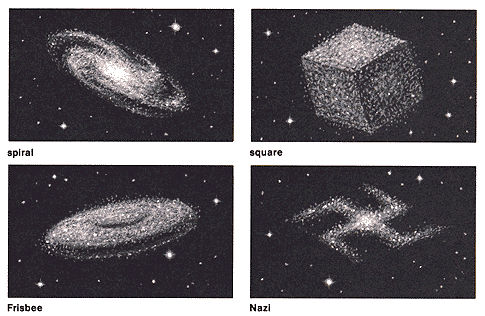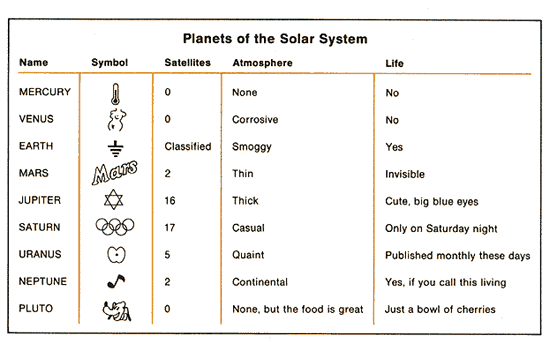Chapter 1
THE UNIVERSE
Pictures in the Sky
The ancients looked at the heavens and saw shapes of gods and animals in the stars. This was probably due to widespread drug abuse in ancient times. Nevertheless, we still use the names they gave the constellations.

The Origin of the Universe
The universe began five thousand years ago with the big bang. All the matter in existence, which had been compacted in a tiny ball, explosively flew apart. No one knows what caused it, but kids playing with matches is suspected.As the primordial matter spread out, it began to coalesce into the celestial objects we know today - galaxies, stars, planets and dust bunnies.
TYPES OF GALAXIES

The Phenomenon of Red Shift | |
|
Even today, the stars and galaxies continue to fly apart. This produces a phenomenon
called red shift. The further away a celestial object is, the more it appears
to astronomers on Earth to be shifted toward the red end of the spectrum. Red shift shows increasing totalitarian domination of the outer reaches of the universe. Write your congressman! |
 |
The Solar System
Many theories had to be tried and discarded before our present understanding of the solar system was achieved. Some primitive peoples, for example, believed that the world was supported on the back of a tortoise, which in turn rode on the back of an elephant, which in turn rode in the back of a '56 Chevy Bel Air.Today we recognize that there are nine planets, each revolving around the sun.
To understand the relative scale of the solar system, imagine that the Earth is a tennis ball in the middle of Times Square. Venus, to the same scale, would be a golf ball in Buffalo. Likewise, Mercury would be a badminton bird in Pontiac, Michigan, and Mars a hockey puck in Calumet City, Illinois.
The sun would be the size of the Hyatt Regency Hotel in Fort Lauderdale, Florida.

The Sun, Moon and Earth
 The sun and the moon are the two most important heavenly bodies in our daily lives.
The sun and the moon are the two most important heavenly bodies in our daily lives.
The sun is the source of all Earth's energies. This is important because one day we're
going to get the bill. The surface of the sun sometimes erupts into giant bursts of flame,
or solar flares, which can disrupt radio and TV communication on Earth. This is
yet another of the sun's beneficial effects.
Blemishes called sunspots also mar the sun's face. Sunspots appear and disappear
in a complex regular cycle. Statistical analyses of these cycles have shown them to be
significantly related to stock market fluctuations, presidential elections and skirt
lengths.
 The moon is our nearest neighbor in space. Its cold, airless surface is covered with
craters and broad seas called maria. This is the origin of the popular lunar song
"They Call the Maria Wind."
The moon is our nearest neighbor in space. Its cold, airless surface is covered with
craters and broad seas called maria. This is the origin of the popular lunar song
"They Call the Maria Wind."
What Holds the Moon Up?
The moon can't fall down because it is in orbit. An orbit is the interaction of a combination of forces - such as gravity, inertia, centrifugal force and others - that result in a perfect balance.Nevertheless, it is a good idea to stay indoors as much as possible.
Eclipses
An eclipse of the moon occurs when the sun passes between the Earth and the moon.An eclipse of the sun occurs when the shadow of the Earth falls on the sun.
An eclipse of the Earth occurs when you put your hands over your eyes.
The Universe / Matter & Energy / The Earth / Evolution / The Descent of Man